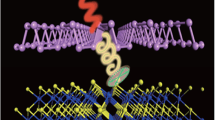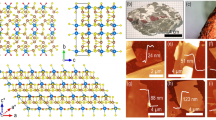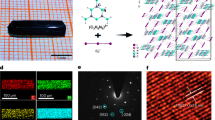Abstract
Composites from 2D nanomaterials show uniquely high electrical, thermal and mechanical properties1,2. Pairing their robustness with polarization rotation is needed for hyperspectral optics in extreme conditions3,4. However, the rigid nanoplatelets have randomized achiral shapes, which scramble the circular polarization of photons with comparable wavelengths. Here we show that multilayer nanocomposites from 2D nanomaterials with complex textured surfaces strongly and controllably rotate light polarization, despite being nano-achiral and partially disordered. The intense circular dichroism (CD) in nanocomposite films originates from the diagonal patterns of wrinkles, grooves or ridges, leading to an angular offset between axes of linear birefringence (LB) and linear dichroism (LD). Stratification of the layer-by-layer (LBL) assembled nanocomposites affords precise engineering of the polarization-active materials from imprecise nanoplatelets with an optical asymmetry g-factor of 1.0, exceeding those of typical nanomaterials by about 500 times. High thermal resilience of the composite optics enables operating temperature as high as 250 °C and imaging of hot emitters in the near-infrared (NIR) part of the spectrum. Combining LBL engineered nanocomposites with achiral dyes results in anisotropic factors for circularly polarized emission approaching the theoretical limit. The generality of the observed phenomena is demonstrated by nanocomposite polarizers from molybdenum sulfide (MoS2), MXene and graphene oxide (GO) and by two manufacturing methods. A large family of LBL optical nanocomponents can be computationally designed and additively engineered for ruggedized optics.




Similar content being viewed by others
Data availability
The authors declare that the data supporting the findings of this study are available in the article and its supplementary information files. Source data are provided with this paper.
Code availability
The codes used for chirality index calculations are available from https://github.com/aslozada/kanon and https://github.com/colombarifm/OPD_chirality_index.
Change history
11 July 2024
A Correction to this paper has been published: https://doi.org/10.1038/s41586-024-07776-4
References
VahidMohammadi, A., Rosen, J. & Gogotsi, Y. The world of two-dimensional carbides and nitrides (MXenes). Science 372, eabf1581 (2021).
Nepal, D. et al. Hierarchically structured bioinspired nanocomposites. Nat. Mater. 22, 18–35 (2023).
Toyoshima, M. et al. Polarization measurements through space-to-ground atmospheric propagation paths by using a highly polarized laser source in space. Opt. Express 17, 22333–22340 (2009).
Ott, M. N. et al. Space flight requirements for fiber optic components: qualification testing and lessons learned. Proc. SPIE 6193, 619309 (2006).
Dupeyroux, J., Serres, J. R. & Viollet, S. AntBot: a six-legged walking robot able to home like desert ants in outdoor environments. Sci. Robot. 4, eaau0307 (2019).
Guo, X. et al. Full-color holographic display and encryption with full-polarization degree of freedom. Adv. Mater. 34, 2103192 (2022).
Fang, X., Ren, H. & Gu, M. Orbital angular momentum holography for high-security encryption. Nat. Photonics 14, 102–108 (2020).
Khoo, I.-C. Liquid Crystals 3rd edn (Wiley, 2022).
Kawamoto, H. The history of liquid-crystal displays. Proc. IEEE 90, 460–500 (2002).
Probst, P. T. et al. Mechano-tunable chiral metasurfaces via colloidal assembly. Nat. Mater. 20, 1024–1028 (2021).
Han, H. et al. Multiscale hierarchical structures from a nanocluster mesophase. Nat. Mater. 21, 518–525 (2022).
Giese, M., Blusch, L. K., Khan, M. K. & MacLachlan, M. J. Functional materials from cellulose-derived liquid-crystal templates. Angew. Chem. Int. Ed. 54, 2888–2910 (2015).
Hu, H. et al. Nanoscale Bouligand multilayers: giant circular dichroism of helical assemblies of plasmonic 1D nano-objects. ACS Nano 15, 13653–13661 (2021).
Lv, J. et al. Gold nanowire chiral ultrathin films with ultrastrong and broadband optical activity. Angew. Chem. Int. Ed. 56, 5055–5060 (2017).
Mao, X. & Kotov, N. Complexity, disorder, and functionality of nanoscale materials. MRS Bull. 49, 352–364 (2024).
Laufer, G., Kirkland, C., Cain, A. A. & Grunlan, J. C. Clay–chitosan nanobrick walls: completely renewable gas barrier and flame-retardant nanocoatings. ACS Appl. Mater. Interfaces 4, 1643–1649 (2012).
Magrini, T. et al. Transparent and tough bulk composites inspired by nacre. Nat. Commun. 10, 2794 (2019).
Suzuki, N. et al. Chiral graphene quantum dots. ACS Nano 10, 1744–1755 (2016).
Jiang, W. et al. Emergence of complexity in hierarchically organized chiral particles. Science 368, 642–648 (2020).
Kurtina, D. A. et al. Induction of chirality in atomically thin ZnSe and CdSe nanoplatelets: strengthening of circular dichroism via different coordination of cysteine-based ligands on an ultimate thin semiconductor core. Materials 16, 1073 (2023).
Kim, Y. et al. Reconfigurable chiroptical nanocomposites with chirality transfer from the macro- to the nanoscale. Nat. Mater. 15, 461–468 (2016).
Gansel, J. K. et al. Gold helix photonic metamaterial as broadband circular polarizer. Science 325, 1513–1515 (2009).
Mark, A. G., Gibbs, J. G., Lee, T. C. & Fischer, P. Hybrid nanocolloids with programmed three-dimensional shape and material composition. Nat. Mater. 12, 802–807 (2013).
Lu, J. et al. Enhanced optical asymmetry in supramolecular chiroplasmonic assemblies with long-range order. Science 371, 1368–1374 (2021).
Zhang, D., Shah, D., Boltasseva, A. & Gogotsi, Y. MXenes for photonics. ACS Photonics 9, 1108–1116 (2022).
Liu, R. & Li, W. High-thermal-stability and high-thermal-conductivity Ti3C2Tx MXene/poly(vinyl alcohol) (PVA) composites. ACS Omega 3, 2609–2617 (2018).
Kumar, P. et al. Photonically active bowtie nanoassemblies with chirality continuum. Nature 615, 418–424 (2023).
Buda, A. B. & Mislow, K. A Hausdorff chirality measure. J. Am. Chem. Soc. 114, 6006–6012 (1992).
Osipov, M. A., Pickup, B. T. & Dunmur, D. A. A new twist to molecular chirality: intrinsic chirality indices. Mol. Phys. 84, 1193–1206 (1995).
Kim, J.-Y. et al. Assembly of gold nanoparticles into chiral superstructures driven by circularly polarized light. J. Am. Chem. Soc. 141, 11739–11744 (2019).
Zhou, S. et al. Chiral assemblies of pinwheel superlattices on substrates. Nature 612, 259–265 (2022).
Purcell-Milton, F. et al. Induction of chirality in two-dimensional nanomaterials: chiral 2D MoS2 nanostructures. ACS Nano 12, 954–964 (2018).
Zhang, H., He, H., Jiang, X., **a, Z. & Wei, W. Preparation and characterization of chiral transition-metal dichalcogenide quantum dots and their enantioselective catalysis. ACS Appl. Mater. Interfaces 10, 30680–30688 (2018).
Salij, A., Goldsmith, R. H. & Tempelaar, R. Theory of apparent circular dichroism reveals the origin of inverted and noninverted chiroptical response under sample flip**. J. Am. Chem. Soc. 143, 21519–21531 (2021).
Albano, G., Pescitelli, G. & Di Bari, L. Chiroptical properties in thin films of π-conjugated systems. Chem. Rev. 120, 10145–10243 (2020).
Yao, Y. et al. Extracting pure circular dichroism from hierarchically structured CdS magic cluster films. ACS Nano 16, 20457–20469 (2022).
Ermolaev, G. A. et al. Giant optical anisotropy in transition metal dichalcogenides for next-generation photonics. Nat. Commun. 12, 854 (2021).
Papadopoulos, N. et al. Large birefringence and linear dichroism in TiS3 nanosheets. Nanoscale 10, 12424–12429 (2018).
Tarjányi, N., Turek, I. & Martincek, I. Effect of mechanical stress on optical properties of polydimethylsiloxane II – birefringence. Opt. Mater. 37, 798–803 (2014).
Aftenieva, O., Schnepf, M., Mehlhorn, B. & König, T. A. F. Tunable circular dichroism by photoluminescent moiré gratings. Adv. Opt. Mater. 9, 2001280 (2021).
Xu, L. et al. Enantiomer-dependent immunological response to chiral nanoparticles. Nature 601, 366–373 (2022).
González-Rubio, G. et al. Micelle-directed chiral seeded growth on anisotropic gold nanocrystals. Science 368, 1472–1477 (2020).
**ong, R. et al. Integration of optical surface structures with chiral nanocellulose for enhanced chiroptical properties. Adv. Mater. 32, 1905600 (2020).
Wu, W., Battie, Y., Lemaire, V., Decher, G. & Pauly, M. Structure-dependent chiroptical properties of twisted multilayered silver nanowire assemblies. Nano Lett. 21, 8298–8303 (2021).
Hubley, A. et al. Chiral perovskite nanoplatelets exhibiting circularly polarized luminescence through ligand optimization. Adv. Opt. Mater. 10, 2200394 (2022).
Liu, J. et al. What makes efficient circularly polarised luminescence in the condensed phase: aggregation-induced circular dichroism and light emission. Chem. Sci. 3, 2737–2747 (2012).
Jiang, S. & Kotov, N. A. Circular polarized light emission in chiral inorganic nanomaterials. Adv. Mater. 35, 2108431 (2023).
Mukthar, N. F. M., Schley, N. D. & Ung, G. Strong circularly polarized luminescence at 1550 nm from enantiopure molecular erbium complexes. J. Am. Chem. Soc. 144, 6148–6153 (2022).
Wu, Y., Li, M., Zheng, Z., Yu, Z.-Q. & Zhu, W.-H. Liquid crystal assembly for ultra-dissymmetric circularly polarized luminescence and beyond. J. Am. Chem. Soc. 145, 12951–12966 (2023).
Dierking, I. Chiral liquid crystals: structures, phases, effects. Symmetry 6, 444–472 (2014).
He, H. et al. Cholesteric-superhelix-enabled reconfigurable circularly polarized luminescence from uniaxially aligned upconversion nanorod films. Laser Photonics Rev. 16, 2200115 (2022).
Neshev, D. N. & Miroshnichenko, A. E. Enabling smart vision with metasurfaces. Nat. Photonics 17, 26–35 (2023).
Kim, W. et al. Thermally-curable nanocomposite printing for the scalable manufacturing of dielectric metasurfaces. Microsyst. Nanoeng. 8, 73 (2022).
Blell, R. et al. Generating in-plane orientational order in multilayer films prepared by spray-assisted layer-by-layer assembly. ACS Nano 11, 84–94 (2017).
He, H. et al. Mueller matrix polarimetry–an emerging new tool for characterizing the microstructural feature of complex biological specimen. J. Light. Technol. 37, 2534–2548 (2019).
Arteaga, O. & Kahr, B. Mueller matrix polarimetry of bianisotropic materials. J. Opt. Soc. Am. B 36, F72–F83 (2019).
Arteaga Barriel, O. Mueller Matrix Polarimetry of Anisotropic Chiral Media. Thesis, Univ. Barcelona (2010).
Oliver, W. C. & Pharr, G. M. An improved technique for determining hardness and elastic modulus using load and displacement sensing indentation experiments. J. Mater. Res. 7, 1564–1583 (1992).
Acknowledgements
This work was primarily supported by the Vannevar Bush DoD Fellowship to N.A.K. titled ‘Engineered Chiral Ceramics’ ONR N000141812876. This work was also supported by the ‘Center of Complex Particle Systems (COMPASS)’ (Grant No. NSF 2243104) and in part by the Office of Naval Research (MURI N00014-20-1-2479), ONR COVID-19 Newton Award ‘Pathways to Complexity with ‘Imperfect’ Nanoparticles’ HQ00342010033, AFOSR FA9550-20-1-0265, Graph Theory Description of Network Material. A.F.d.M. is indebted to CNPq and FAPESP (grant 2013/07296-2) for their financial support. We are grateful for the HPC resources provided by the SDumont supercomputer at the National Laboratory for Scientific Computing (LNCC/MCTI, Brazil, http://sdumont.lncc.br). A.J., B.S., R.V. and D.N. are grateful for support from the Materials and Manufacturing Directorate and Air Force Office of Scientific Research of the Air Force Research Laboratory. Michigan Center for Materials Characterization (MC)2 is acknowledged for instrument support. Early discovery of amino acid decoration on MoS2 by M. Zhou is gratefully acknowledged.
Author information
Authors and Affiliations
Contributions
J. Lu and N.A.K. designed the experiments and analysed the data. J. Lu fabricated the composites. W.W. prepared the Ag film, ran the mechanical testing and contributed to property discussions. J. Lu, K.W. and W.W. ran the AFM imaging and studied the structure of composites. A.J., N.C. and R.V. prepared the MoS2 nanoplatelets. B.S. and D.N. synthesized pristine Ti3C2Tx nanoplatelets. F.C. and A.F.d.M. performed the density functional theory and molecular dynamics simulations and chirality index calculations. X.Z. and J. Lahann performed the measurement and data analysis for the refractive index of Ti3C2Tx composites, which was used by J. Lu on finite-difference time-domain simulations. W.C. assisted J. Lu with MMP measurement and contributed to property discussions. J. Lu, W.W., F.C., A.F.d.M., D.N., R.V. and N.A.K. contributed to the writing of the paper, with feedback from all authors. N.A.K. conceived and supervised the project.
Corresponding authors
Ethics declarations
Competing interests
The authors declare no competing interests.
Peer review
Peer review information
Nature thanks Pengfei Duan and the other, anonymous, reviewer(s) for their contribution to the peer review of this work.
Additional information
Publisher’s note Springer Nature remains neutral with regard to jurisdictional claims in published maps and institutional affiliations.
Supplementary information
Supplementary Video 1
Distribution of electrostatic potentials of L-Cys-capped MoS2 nanoplatelets under different excitation wavelengths.
Rights and permissions
Springer Nature or its licensor (e.g. a society or other partner) holds exclusive rights to this article under a publishing agreement with the author(s) or other rightsholder(s); author self-archiving of the accepted manuscript version of this article is solely governed by the terms of such publishing agreement and applicable law.
About this article
Cite this article
Lu, J., Wu, W., Colombari, F.M. et al. Nano-achiral complex composites for extreme polarization optics. Nature 630, 860–865 (2024). https://doi.org/10.1038/s41586-024-07455-4
Received:
Accepted:
Published:
Issue Date:
DOI: https://doi.org/10.1038/s41586-024-07455-4
- Springer Nature Limited





